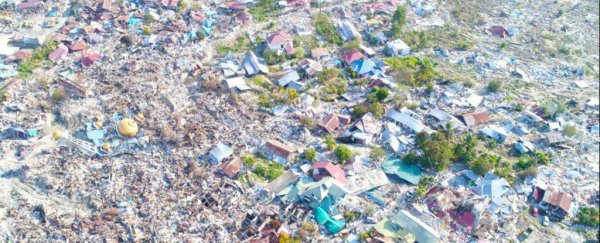When an earthquake struck near the Indonesian island of Sulawesi on September 28 last year, thousands of people lost their lives. Dragged out to sea, buried in mud, they were the victims of 2018's most devastating earthquake.
Satellite data has now revealed that the grinding sections of crust responsible for the 7.5 magnitude tremor unravelled at breakneck speeds. The velocity is startling for a fault of this nature, but it could help explain the power of such stand-out seismic events.
Two recently published studies on the 2018 tremor have provided strong evidence that the rupture behind the catastrophe moved at what's described as a supershear velocity.
Earthquakes all start somewhere. Mounting pressure between titanic pieces of crust can only build so far, until a weakness finally gives way into a planet-jarring rupture that shifts along the fault, easing each plate into new positions.
Pulses of energy called shear waves spread out through the crust in all directions, felt as the jarring jiggle of an earthquake. But the adjustment of the plates themselves propagates at a speed set by the friction of surrounding geology.
That puts a limit on most ruptures of roughly 3 kilometres per second, slightly slower than the shear waves which typically move at around 4 to 8 kilometres per second.
Supershear earthquakes buck this trend, shooting forward at speeds that overtake the ripples to create what is effectively a ground-shaking sonic boom.
While not exactly common, they've been observed a handful of times in recent history, and are even thought to be behind the cataclysm that struck San Francisco in 1906.
If the one that hit Indonesia last year was a supershear earthquake, it would go a long way to explain its intensity. There's just one problem – the fault line behind the quake isn't what we'd expect of supershear structures.
Sulawesi sits in the midst of a jigsaw puzzle of tectonic plates. The most active junction is the Palu-Koro fault, comprised of plates that slide laterally against one another in opposing directions in a 'strike-slip' fashion.
For strike-slip ruptures to move at supershear velocities, the rupture should theoretically begin in a slightly rougher zone before building up speed down a smooth straight.
Zig-zags and structural complexities in the Palu-Koro fault would make it hard for a rupture to build up much speed, or so it was thought.
There were some early signs that the 2018 quake was a fast one. Aftershock data and satellite imagery suggested it took just 35 seconds to jump a distance of roughly 150 kilometres (about 93 miles) along the fault.
So a team of researchers from the University of California, Los Angeles, used teleseismic data and remote sensing of the quake to come up with detailed imagery of the rupture process, getting a precise measurement of the velocity as 4.1 kilometres (2.5 miles) per second.
This rapid pace isn't quite up to the blazing velocities of other supershear quakes. A magnitude 7.5 tremor that hit Alaska in early 2013 was believed to race down the fault at 5.5 to 6 kilometres (3.4 to 3.7 miles) per second.
But the Palu-Koro fault isn't typical. Its unique mess of shattered rocks left by a history of quakes could help explain why it didn't break any record speeds.
A separate study by researchers from the Université Savoie Mont Blanc in France adds additional detail to the fault's structure.
Satellite imagery was used to map the main rupture and secondary structures associated with the slip. A picture emerged of a previously undescribed section of fault that was highly complex.
From there, the slip extended south a total distance of 180 kilometres (112 miles), pushing through two major kinks and then down a 30 kilometre (19 miles) straight past the Sulawesi capital of Palu.
This relatively short, extremely smooth straight appears to be the culprit for the quake's supershear jump, causing it to blast off at top speed rather than taking a run-up.
"Even in these complicated and rough faults, it can go supershear and it can go supershear right away," UCLA seismologist Lingsen Meng told Paul Voosen at Science Magazine.
Whether a catastrophe of this magnitude will repeat in Sulawesi's future is anybody's guess. While the tsunami appears to have been a case of bad luck, seismologists have a long way to go before they can accurately predict the size of tremors.
Knowing that 'sonic boom' tremors like these can occur in faults such as Palu-Koro could at least help identify the potential for disasters more accurately in the future.
This research was published in Nature Geoscience here and here.
